March 21 (Sat), 2008
#1 Spence Zaorski
Graduate student majoring human sciences & communication media/
Rakugo researcher
(He's been in Japan since 2006)
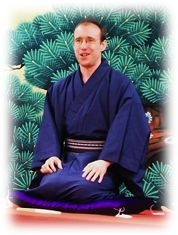
One rakugo performer is holding very simple tools and create anything by themselves.
That's the magic of rakugo.
My Eyes Tokyo went west to Osaka and Kyoto (cities in Kansai region, western Japan) then we had interviews with two foreigners. Both of them really loves one of the traditional Japanese art called "rakugo"(落語).
Rakugo is a Japanese verbal entertainment. Look at a picture above. A guy wearing kimono sits on a cushion and tell comedic stories to the audience.
"Raku" means "fall", "Go" means "Words" then "rakugo" means "punchline". (see more → Click) . Rakugo has a very long history and people need to know much about Japanese way of life or Japanese traditional things in order to understand it. But they know those things and rakugo much better than average Japanese people.
First interviewee on this series is Spence Zaorski, an American grad student. He is studying and researching communication technology and media at a university in Osaka. Originally he was working in the information technology area in US.
He is trying to transmit how rakugo is useful for people universally with his technical background and cross-cultural experience. He is like a "missionary of rakugo" from America. Why was he attracted that typical traditional entertainment? What is the appeal of rakugo for him?
*Interview at "Cairn" (Tenjin-bashi, Osaka)
Rakugo Clip 1: Kamigata (Osaka) Rakugo
Encounter rakugo in the Motown Detroit.
I'm not in the Japanese section like Japanese literature or Japanese culture. So my interest in rakugo started personally.
I had Japanese satellite television when I was in US so I could watch rakugo programs there. And I actually lived in Japan previously in '94 and I watched them on TV in Japan as well.
A lot of traditional culture that I've studied was very interesting. But in particular, rakugo just caught my interest along the way and I got more and more interested in it.
When I went to see a live rakugo performance in Detroit. There's a large Japanese population because of the car industry. I went to see Katsura Sanshi's live event there (He is a nationally-known rakugo performer who is originally from Osaka). Then I just got hooked on it.
I wanted to start to know more about it and I wanted to learn it. I ordered books from Japan on Amazon and I even bought videos and CDs. I found rakugo events in New York and other places like Chicago and I went to see them.
The speaking skills of rakugo can be very valuable.
Speaking skill of rakugo is not just about comedy. Its rhythm is the method of engaging people and taking your audience on an adventure. And it's keeping their interests over a period of 20-30 minutes, sometimes even longer.
You need those skills in your life when you talk to people, or in business scenes when you make a presentation. I thought you can learn a lot from rakugo and you can apply what you learned to other areas. So that has become one of my areas and interests with my research as well. I think the speaking skills can be very valuable for anybody, especially for education or for students because it's an international world now.
Rakugo is very two-way. It's the engagement of the audience. While they are not speaking back to you, they are replying with their laughs. So I think those skills are valuable for students, too. And the best way to break down international communication barriers. I think the core skills of rakugo can help people to become international communicators.
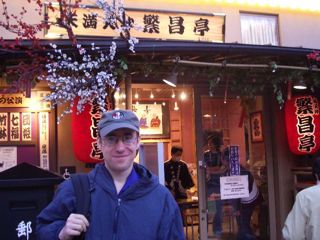
In front of the entertainment hall "Hanjo-tei"
I got interested in Japan, which is totally different from US.
I got interested in Japan in grade school. I had a couple of books on Japanese. I had this interest in foreign languages but something drew me to Japan. I think Japanese culture is so different than anything else. America is a melting pot. There are so many cultures, languages and other things. I think it's very different from Japan and It was interesting for me. So I tried to learn Japanese on my own.
When I got to college, I finally had a chance to study the language and I found there were events. I was in Cleveland, Ohio and I found all these Japanese-related events such as art and film. So I went there as much I could.
I got involved with Japan America Society and became one of the founding members of its Cleveland bureau. It was great because the more I studied about Japan, the more I got interested. So I kept getting more and more into it.
My room in Cleveland.
When you first walk in my room, you take off your shoes. Then you walk over and you see the TV. You notice that they are not speaking English on TV. It's NHK, the largest broadcaster in Japan. I had a satellite broadcast of NHK 24/7. I had that on almost all of the time.
You're looking around a room and find a little low table. And there is a cushion in front of that low table. A low table is called "Chabudai(ちゃぶ台)", a cushion is called "Zabuton(座布団)". And I slept on a futon.
Also I had "Noren" (のれん/暖簾: traditional Japanese fabric dividers) and saying "Yu" (湯: Hot spa or bathhouse) leading to the bathroom.
I had a Japanese sword, too. It was not a real one. It's a practice sword because I did Japanese martial arts in the US. I started studying them in '89 or '90.
You have to know people to understand sense of humor.
Comedy is the hardest thing because sense of humor varies by countries to a certain extent. A lot of comedy is based on nuances, words and also culture. You have to know the people. You need to watch Japanese TV and you see somebody doing monomane (impersonation) impressions. So I watched a lot of Japanese TV program in US.
I started to see Japanese dramas and that helped me to give me that background to understand Japanese culture. It took a long time to get to a certain point. But if you keep studying and pushing forward, you can develop those skills.
There's an older Japanese language with Kamigata-rakugo (上方落語: a rakugo style performed in Kansai region) and also there's an Osaka dialect. Then rakugo has its own history and culture.
In rakugo, they are talking about Edo Period. So there's a lot of things you have to know in order to understand it.
My American friends enjoyed rakugo.
I took some of my friends to a rakugo event and they said that they understood maybe 10% of it. But they still enjoyed it thanks to its rhythm and action. As well, the faces of the characters.
So even if they didn't get the whole thing, they might enjoy it to a certain level. But it's very deep as well.
So if you think you understand it now, you can continue studying more and you can understand it. Then you'll appreciate it even more.
People may say, "Oh, it's the same story as I heard before. How many times can you hear the same story over and over?" But really, each time they do it, it's a unique experience. And it's an interaction with a crowd and the location they do it.
I try to learn as much I can. Actually I'm not only watching rakugo but also studying it from professional performers. So I'm also studying how performers are doing it and what people laugh at. How the same story is different from the last time or how it's different from a different person's version. I'm watching it on many different levels now.
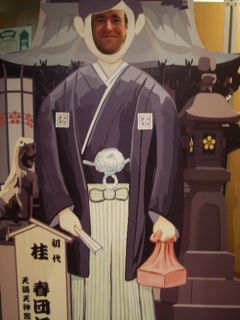 At Hanjo-tei.
At Hanjo-tei.
Magic of rakugo.
In rakugo, you don't move. You're sitting in a seiza (正座) ,kneeling on a cushion, so you can't move a lot. And you're wearing traditional Japanese clothes. You're using basically a fan (sensu:扇子) and a small washcloth (tenugui: 手ぬぐい).
But you can create anything by using them. I think that's the magic of rakugo. Nowadays Hollywood spends on movies to recreate old scenes or to go to space. They hire people and they use computers to create special effect and recreate even entire towns.
On the other hand, one rakugo performer is holding very simple tools and creating anything by themselves. They can create that old town in the Edo Period and they can even go to America. They can go into space, into the future. They can create any number of people, from young child all the way to grandparents, or even a crowd of people. That's the amazing thing about rakugo.
It taps into what this new media generation forgets, the creativity. I think rakugo creates that to root art, basically depends on the creativity of each person. I think that's a great skill that we need to develop more of in education. Creativity is definitely important. Technology allows us to do things easier and in many cases it replaces certain jobs that people normally had to do. So what's left? I think it's "Creativity".
Rakugo and standup comedy.
When you look at comedy in the West, it's different. If you say about comedy like an individual standing on a stage, American comedians do very short fits and things are political and a little bit racy nowadays. But there's a reason for it.
If you look at where rakugo is done, there's a specialty house called yose (寄席). But there are also the small events where you go to anything from a coffee shop to a school, whatever. And some stories are performed for 20 or 30 minutes.
But in US, comedy is typically done in a nightclub. So American comedy has to be short, quick and very easy to react to because people are drinking or they are out with their girlfriends. It's an entirely different environment they're performing in. Even if you see the top comedians on TV doing special shows, all started out typically from a nightclub circuit or comedy club circuit.
But a comedy club is the same thing. People drink there. It's not the same type of environment as rakugo. Even on TV, comedians are making fun of the president.
Whereas in rakugo, maybe some performers talk about political things a little bit in a story before entering the main story. But I think there are two different cultures of humor that have developed over time.
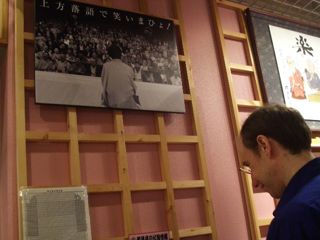 A sign says, "Let's laugh together!"
A sign says, "Let's laugh together!"
I want to introduce young people to rakugo.
I'm enjoying rakugo personally but I want more people to understand it. People might think it's an old art that may be not very interesting. People that have never seen it have an image like that. I'd like to introduce those people to it. So everything that I do needs a lot of information and experiences and I will try to compact them.
If I find interesting parts of things that can be useful, I will broadcast them and engage people with them. If they might be interested in them, I just generate that spark. That's an initial introduction. In my case, the spark was Japanese food and it lit. Then I had a lot of sparks and I got interested in other cultures. I just want to create that opportunity to come, contact and understand what rakugo really is for people that I meet. They can find a way to use technology. Or rakugo might be useful or interesting to them.
Rakugo is an art with over 300 years of history behind it. Just understand that it has that background. That's enough. Children are doing rakugo. I think it's a great thing. People don't have to study about it. If you have an interest, you can do it.
Rakugo Clip 2: Edo (Tokyo) Rakugo
The connector.
Japanese might be forgetting their roots. It's the same in the US to a certain extent. People come from abroad to the US. and know a lot more about the US than I do. If you are born in a country, it's always there. You don't need to study about it because it will always be there.
But I think traditional culture is not just an old art that exists back in the Edo period or something. It's a living and breathing art. And rakugo is a great art which has a strong tradition of passing down information and experiences from one generation to the next, person to person.
We're going to see the end of the rakugo drama soon ("Chiri-tote-chin"; A story of rakugo performers in Osaka. It was broadcasted on NHK until March 29, 2008). But hopefully people will still be interested in rakugo. Hopefully a lot of people will say, "I didn't know that rakugo was that interesting!" And actually the image will change and they might go to see it. And potentially they build out their interest and really increase their interest in the art.
So my goal is to be the connector for people to the traditional culture or finding out very easily how rakugo could be interesting for them. If I can do it on larger scale, it helps to keep spreading interest.
Rakugo goes international.
I will do that not just in Japan, but also in overseas. Because I think the art, underneath it all, is not tied to Japan. English rakugo is a good example. You can perform it in another language and people enjoy it in overseas because we're seeing a lot of professionals going to New York.
Japanese culture and language are also very important for preserving the essence of the historical art. But you don't have to be tied to that. There is just an element that can make it. The art of speaking, the art of communicating and engaging people. You can take out those parts and use them in your own way.
My another goal is to use my experience, and skills to facilitate it. The more I can facilitate that where people can find information and learn about it, and help other people to connect with it, then we can help keep expanding our knowledge and help generating interest. And basically we will help to preserve the art and develop it further in the future as we go international.
Rakugo can prevent conflicts.
I think really the key to preventing unnecessary conflict is good communication and understanding of your country and own culture.
Whether the essence of rakugo can be useful for preventing conflicts depends on communication skills. It's the same with understanding culture and being international. It's an international society now and you can't just exist in your own world because there's an interaction between them. So I think more than ever it's essential to have good communication skills and to build them to understand cultures.
I'm actually very excited at the possibility of rakugo. More and more projects are beneficial to people in Japan and people around the world.
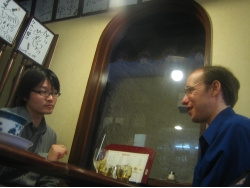 *Photos by Akiko Kawane
*Photos by Akiko Kawane
I really enjoy life here in Kansai area.
People are great. There's a great culture. Kyoto has a traditional culture, Kobe is an international port city. Nara also has a very traditional culture and a lot of history.
And Osaka is the merchant city. There's a cheap but delicious food. I really feel rooted here.
It's a kind of like another home away from home for me.

 Previous
Previous